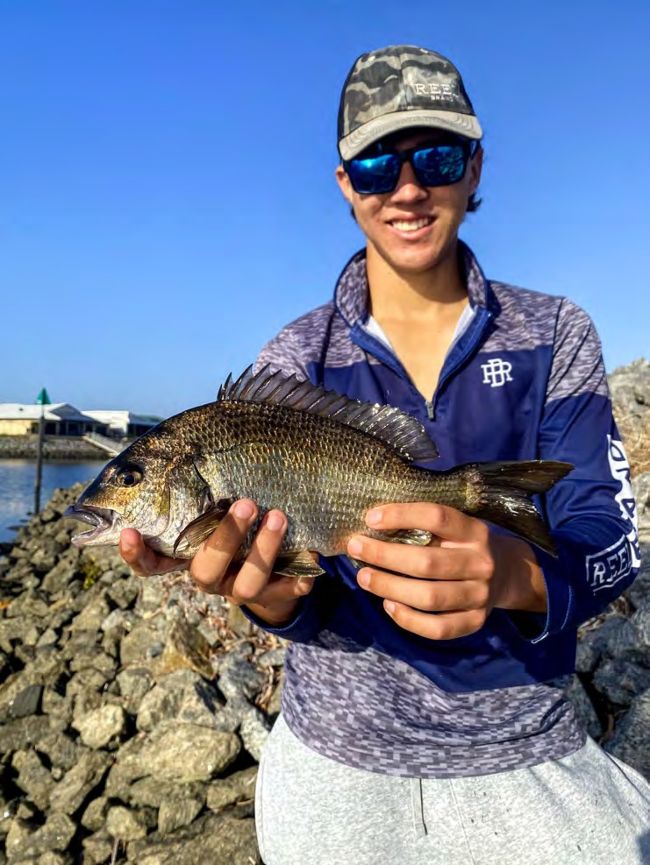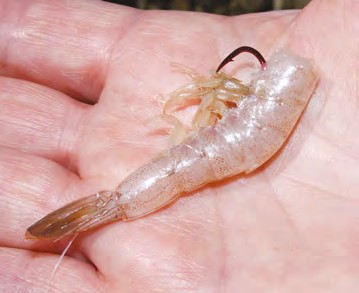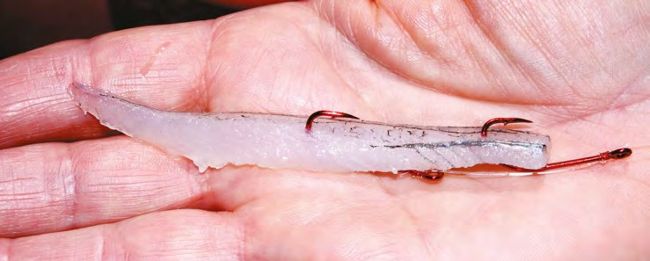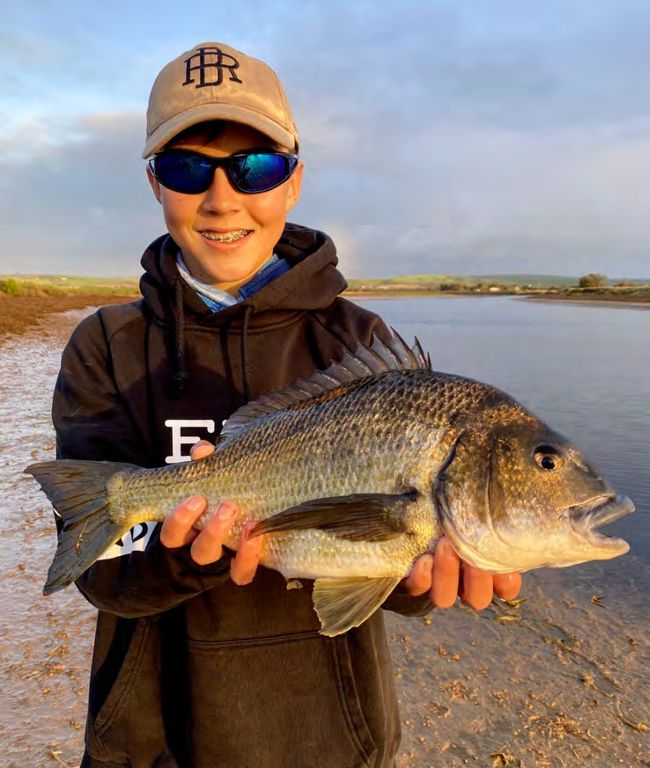OUTSMARTING BREAM WITH BAIT
Archie Coote goes retro, providing the good oil on fooling big inshore bream with natural baits.
The southern black bream is an extremely smart species of fish, desirable not for their eating quality, but their fighting ability.
In South Australia they are often spotted in the shade of pontoons in our marinas or in shallow estuaries. Being able to see the fish makes it more frustrating when they will not take a bait off the trusty paternoster rig. They frustrated me for years, always fishing the Port Lincoln Marina on windy days when there is nowhere else offering protection.
A bream would always turn away from my plain rig with two hooks, a sinker, and some sloppy squid tentacle. The reason that southern black bream are remarkably skilled in distinguishing the safe from the sorry is their achievable age. At the legal length of 30cm it is believed they are upward of 10 years old, and fish of 40cm or more are north of 20 years old. This challenge is what draws many anglers into targeting bream and attempting to outsmart them by thinking outside the norm. There are many minor details that need to be considered before dropping a line.
FINDING THE SECRET
During a fishing session in the hustle and bustle of a marina next to some vessels unloading tuna, a range of species gathered around, smelling blood and oils oozing from the ship’s holds. Amongst them some behemoth bream emerged and caught our attention as an upgrade from little tommies. From our point of view they looked like grey snapper and were mistaken as such by surrounding anglers. Some fish would have been pushing 50cm!
These fish were our kryptonite, so we first experimented by changing our weighted rigs for un-weighted ones with a single longshank hook at the end. Throwing a small frozen prawn on the hook and lightly casting it into the mix of bream, a decent fish followed it down to the bottom and finally made a move, pinching the bait with its crushing teeth and screaming away for a split second before spitting the hook. Unfortunately, an escapee bream usually disheartens the rest of the school and they moved on.
Now that we had found what entices a bream to bite, the following day we would continue to test our hypothesis. We caught and released half a dozen 30-37cm bream, all putting up a hearty fight. We were learning more each time.

Releasing a big marina bream, hooked on a prawn
SEARCHING AND ATTRACTING
As mentioned previously, walking across pontoons or the outskirts of the selected location is efficient when searching for bream. On clear and calm days, dirty sections of a channel are an illustration of bream feeding. They dig around for critters hiding in sand holes or between rocks.
Sneakily sight casting bream and making the slightest of splashes can be an effective way of getting a bite. Since bream hang in schools, when they are clearly visible it is important to keep distance and not disturb them. Finding a school of bream is the first step. Firing them up or attracting more fish to the location is step two. Instead of throwing berley pellets into the water, using the same bait as berley can be influential. Breaking up the same prawns being used for bait and throwing them into the breams’ vicinity will provide a natural source of food, along with blending in with your bait, and keeping unwanted species away due to the lack of smelly oils. Even though bait is quite costly, the more bait purchased will result in more berley and more likelihood of fun. If they notice a hint of unknown substance, they will not bite, such as berley pellets.
BAIT VARIETY AND PRESENTATION
The variety of baits for the fishing adventure is as large as the variety of lollies in an Allen’s Party Mix, but nobody likes eating every kind of lollie in the bag, so working out what bream are most likely to eat is key. Think of what species of sea creatures live in bream territory and they should be prime suspects. Popular baits are cockle flesh and small prawns, since they are in most bait and tackle stores, but sometimes these are so popular, bream will avoid them. I will not only take a bag of cockles or prawns, but also bluebait/ whitebait bags, a pack of pilchards and try and catch some small legal tommies or salmon trout. Salmon trout flesh is oily and attractive to bream, and even better is slimy mackerel. After a few sessions of catching fish, it may become clear as to what baits work best, meaning less can be taken.

Prawns and whitebait are bream fishing staples
Presenting bait perfectly is a tricky thing to master and the style of hook and shape of the bait are all factors that apply. Simply put, rigging a bait with the hook as well hidden as possible will increase the chance of persuading a bream to bite.
BAIT PRESENTATION: FISH FILLETS
First are fish fillet strips. Many anglers would know that silver trevally strips outclass most King George whiting baits, and the same can be said when targeting bream. Strips of the fish fillet should be around 3-5cm long by 2cm wide. Baitholder hooks are excellent for baiting fillets and are occasionally paired as ganged hooks. However, these are hard to come across in smaller sizes. This is where you must obtain a pair of pliers and make some for yourself.
Using a pair of hooks that are disconnected will provide more flexibility with different sized baits. If two hooks are being used, it makes it easier to stabilise the bait and hold it in position to leave plenty of pointy, sharps barbs exposed. A single hook would either require the hook to be passed through the bait completely before being reinserted to stabilise the bait. Using a scaled fish fillet will enhance scent release and make it easier to set the hook. Rigging presentable baits is a delicate procedure; it also takes a while to consistently get right, but the rewards are worth the work.
PRAWNS
Prawns make up the staple diet of bream, as they are abundant in estuary systems or anywhere that has acceptable structure. Using a prawn that has been frozen whole is critical since we are presenting the most natural bait conceivable. The shape of prawns is rounded, which makes rigging them up laborious, so the hook choice is paramount. My favorite hook for rigging prawns has been a size 8 or 6 bait holder. Firstly, measure the selected prawn up against the hook with the hook eye at the connection point between the body and head. Where the hook’s curve leaves the prawn is the exposure point. Making a first insertion between the head and body until you reach the middle and most durable part of the prawn prevents bait thieves from freely ripping the bait apart. Do this like you would be threading a soft plastic onto a jig head; since the bait has been measured appropriately to the hook exit, it should reveal itself around the tail, depending on the size of the prawn.


Bait presentation can be crucial. Take time and care
BLUE/WHITEBAIT
These are like miniature pilchards, and can be rigged similarly to their larger counterparts. They are much easier to thread on compared to other baits since their straight shape is easy to work around. Most whitebait found in fishing bait stores are around 6-9 cm long. As mentioned before, you can make small hook/double gang rigs, but instead I use limerick hooks in size #8. Using a single hook will give natural presentation with some threads and weaves included. With a single hook, the procedure begins with threading the hook completely through the eye, making it a through-line bait, then pinning the hook through the bait roughly halfway down. To keep the bait more secure, when making this incision, go through the spine of the bait. Definitely give whitebait a try, as they outfish most baits, are the easiest to rig and are also great berley.
OUTFITS AND TECHNIQUES
Taking two or three rods when bream fishing will allow you to cover lots of ground while using baits. As mentioned previously, using different bait on each outfit will narrow down what the big bream are feeding on that day. The technique is very hands-off. In a marina I cast towards structure or the side of a moored boat, which are living quarters for bream, and let the bait sink to the bottom. In an estuary, look for deeper channels or areas with stronger current. Casting into this current will allow your bait to move to where the fish are, waiting for anything to be washed towards them. After the bait hits the bottom, open the bail arm and double check on any knots around the guides of the rod or spool. Sit and wait for the line to start peeling freely, indicating a fish has taken the bait. After a couple of seconds of the line being tight, the trademark of a bream is to speed up and move to shelter, and this is when you strike.

What it’s all about!
To clarify quickly, an affective bream rig cannot get simpler. It is simply the choice of a hook tied on the with any choice of knot at the end of a couple arm lengths of fluorocarbon leader. No sinkers, no swivels, no beads. — nothing! If a bream feels the slightest bit of unusual weight, it will drop the bait. The rod and reel combo are required for casting, hooking, fighting and lifting the prize catch on the day. Using light tackle is the way to have some entertainment when hooked up and only requires a 1000 or 2500 reel with an excellent drag system. I use 10lb fluorocarbon leader, but on slow days change to 8lb or 6lb, since it’s practically invisible under water and harder for the fish to distinguish. This, paired with matching 6lb braid, makes for an entertaining fight.
There’s no doubting southern black bream are endlessly frustrating. Make sure to do the right thing and release these wonderful creatures, as they are not regarded as delicious fish. Sometimes the hook can be set deeply into the fish’s throat, and removing it can cause damage, so cutting the line and sacrificing a hook will give the fish the best chance of making a healthy recovery. Hopefully, it is now possible for you to outsmart bream with bait.